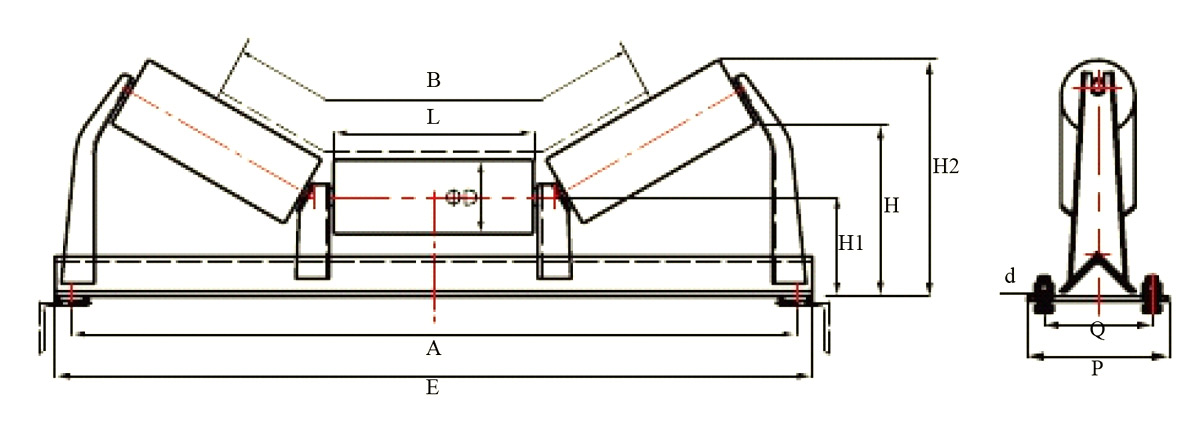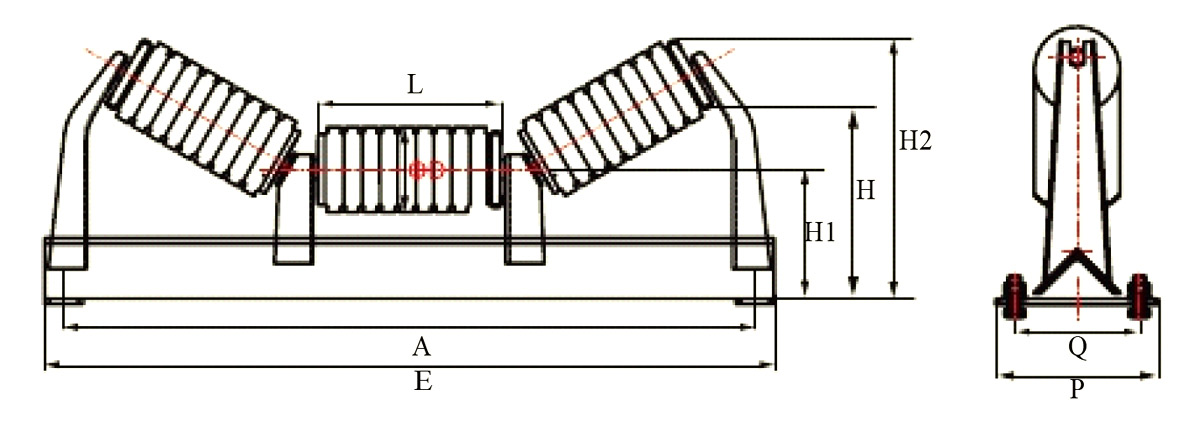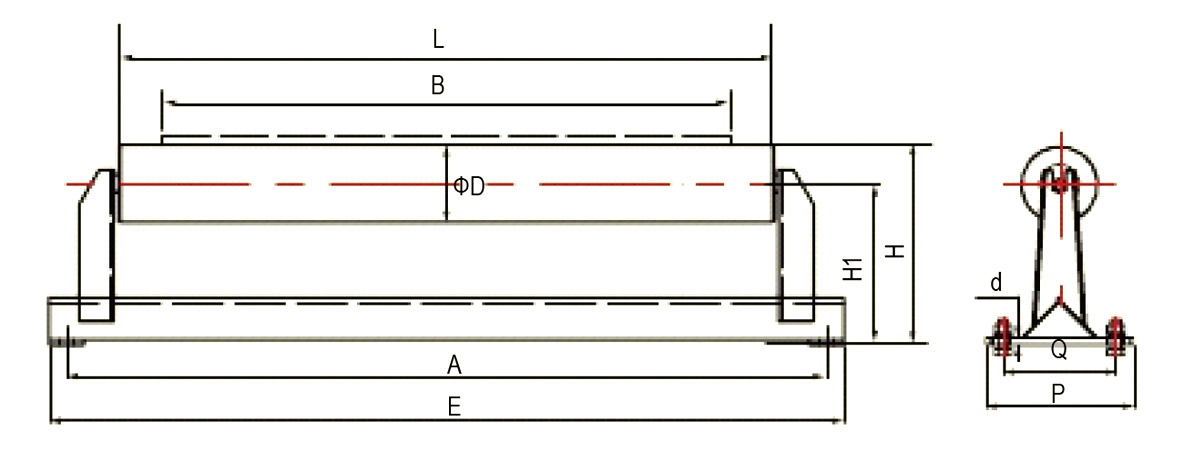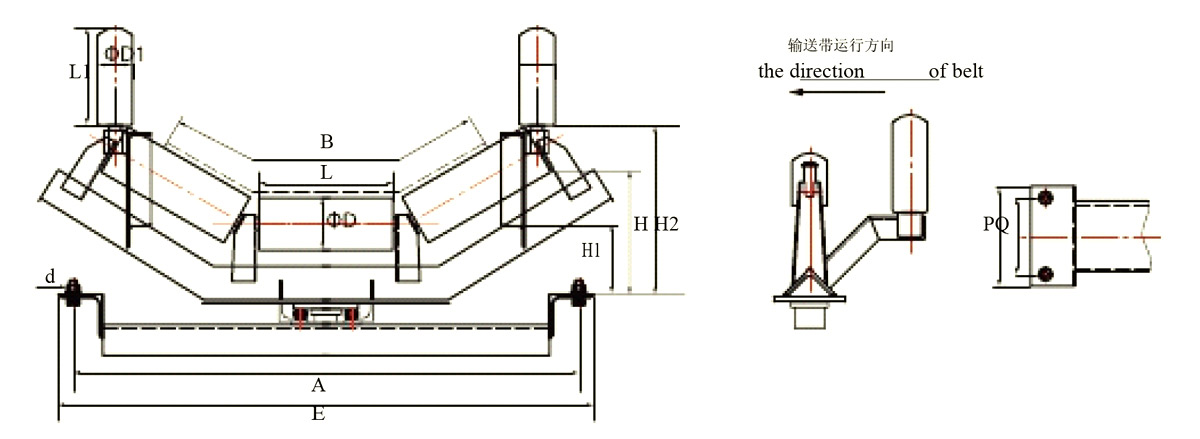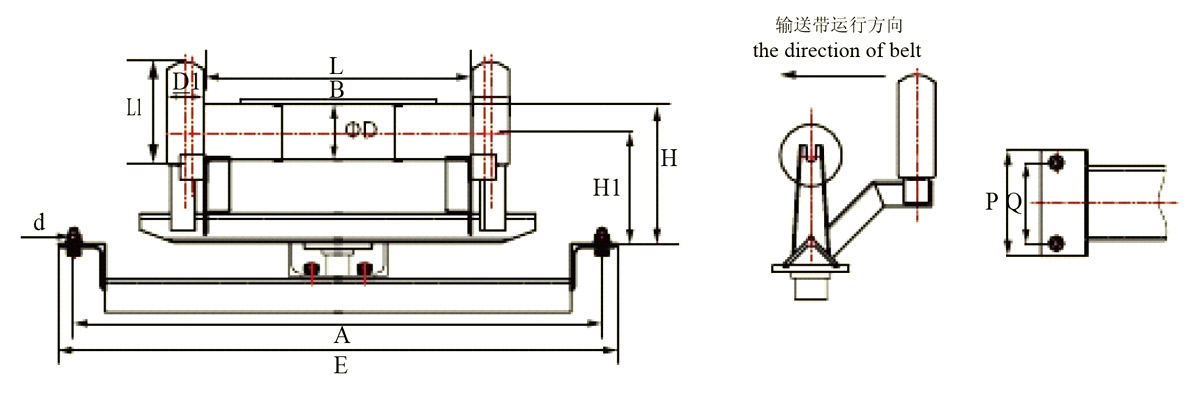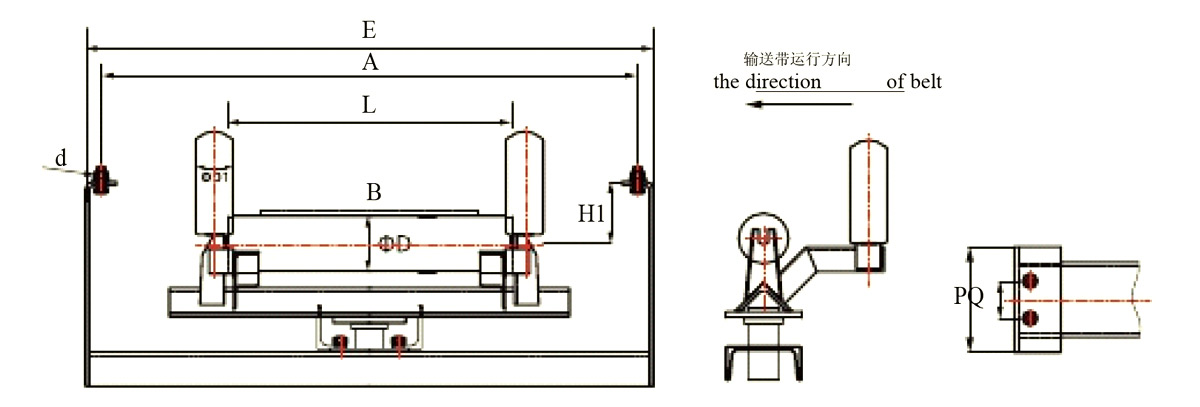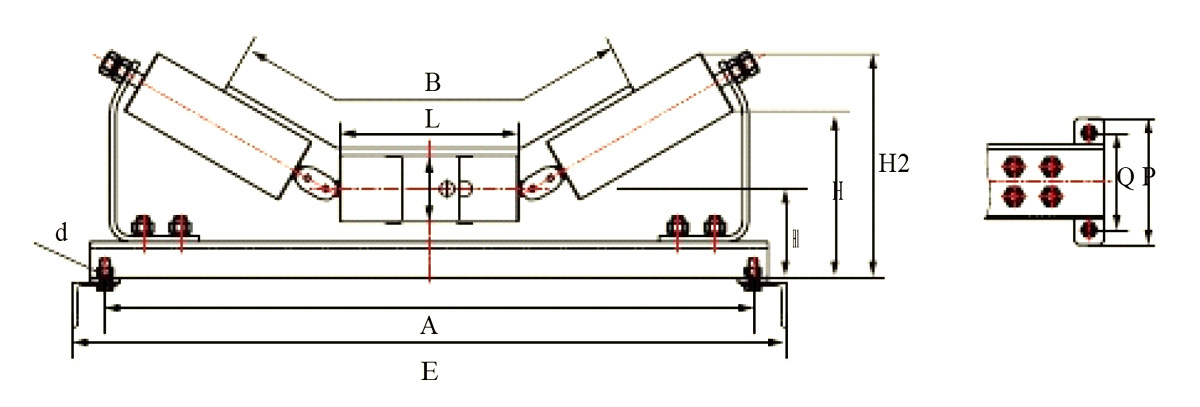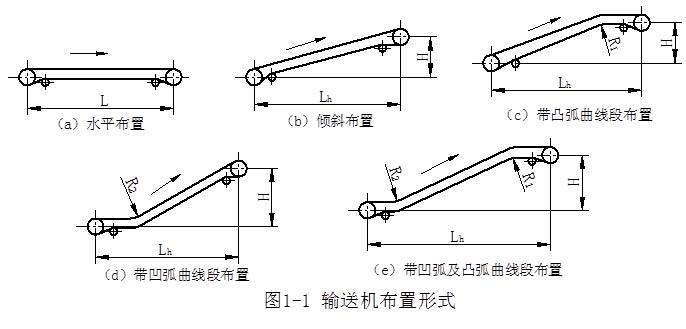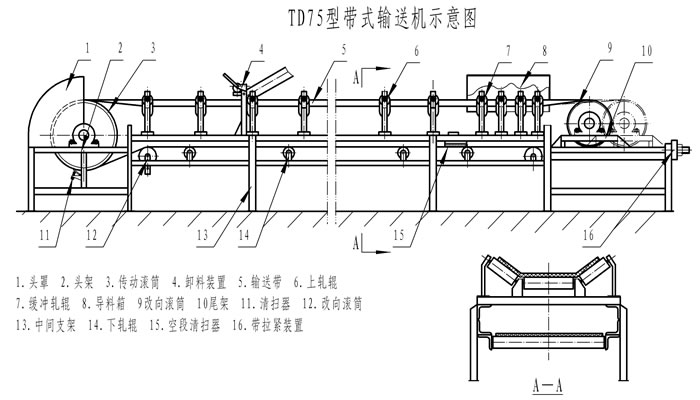TD75 belt conveyor system for power station
TD75 belt conveyor
- Feed size: ≤400mm
- Production capacity: ≤800t/h
- Application scope: widely used in metallurgy, mining, coal, port, transportation, hydropower, chemical industry and other sectors
- TD75 belt conveyor has the advantages of large conveying volume, simple structure, easy maintenance, low cost, strong universality, etc. The material lumpiness allowed by the equipment mainly depends on bandwidth, belt speed, slot Angle and inclination Angle, and also depends on the frequency of large materials
TD75 Idler
● Carrier trough idler
| Belt width | Drawing NO. | Roller | Bearing No | Bracket Thickness | Bottom Bracket | Angle No. | (KG) Bracket Weight | |||||||||
| D | e L | A | E | H | H1 | H2 | P | Q | d | Thickness | ||||||
| 500 | TD1C1 | 89 | 190 | 204 | 720 | 760 | 210 | 125.5 | 266 | 170 | 130 | M12 | 3 | 6 | 63*63*6 | 6.73 |
| 650 | TD2C1 | 89 | 240 | 204 | 870 | 910 | 230 | 125.5 | 291 | 170 | 130 | M12 | 3 | 6 | 63*63*6 | 7.94 |
| 800 | TD3C1 | 89 | 305 | 204 | 1070 | 1110 | 240 | 125.5 | 323 | 170 | 130 | M12 | 3 | 6 | 63*63*6 | 9.13 |
| 1000 | TD4C1 | 108 | 375 | 305 | 1300 | 1350 | 300 | 156 | 400 | 220 | 170 | M16 | 4 | 8 | 75*75*8 | 17.84 |
| 1200 | TD5C1 | 108 | 455 | 305 | 1550 | 1610 | 330 | 176 | 460 | 260 | 200 | M16 | 4 | 8 | 75*75*8 | 27.3 |
| 1400 | TD6C1 | 108 | 525 | 305 | 1750 | 1810 | 350 | 176 | 495 | 260 | 200 | M16 | 5 | 10 | 100*100*8 | 30 |
Rubber ring cushion cushion cushion cushion idler
| Belt width | Drawing NO. | Roller | Bearing No | Bracket Thickness | Bottom Bracket | Angle No. | (KG) Bracket Weight | |||||||||
| D | e L | A | E | H | H1 | H2 | P | Q | d | Thickness | ||||||
| 500 | TD1C9 | 89 | 190 | 204 | 720 | 760 | 210 | 125.5 | 266 | 170 | 130 | M12 | 3 | 6 | 63*63*6 | 6.73 |
| 650 | TD2C9 | 89 | 240 | 204 | 870 | 910 | 230 | 125.5 | 291 | 170 | 130 | M12 | 3 | 6 | 63*63*6 | 7.94 |
| 800 | TD3C9 | 89 | 305 | 204 | 1070 | 1110 | 240 | 125.5 | 323 | 170 | 130 | M12 | 3 | 6 | 63*63*6 | 9.13 |
| 1000 | TD4C9 | 108 | 375 | 305 | 1300 | 1350 | 300 | 156 | 400 | 220 | 170 | M16 | 4 | 8 | 75*75*8 | 17.84 |
| 1200 | TD5C9 | 108 | 455 | 305 | 1550 | 1610 | 330 | 176 | 460 | 260 | 200 | M16 | 4 | 8 | 75*75*8 | 27.3 |
| 1400 | TD6C9 | 108 | 525 | 305 | 1750 | 1810 | 350 | 176 | 495 | 260 | 200 | M16 | 5 | 10 | 100*100*8 | 30 |
Carrier Carrier Carrier Carrier flat idler
| Belt | Drawing NO. | Tube | Bearing No | Bracket Thickness | Bottom Bracket | Angle No. | (KG) Bracket Weight | ||||||||
| width | D | e L | A | E | H | H1 | P | Q | d | Thickness | |||||
| 500 | TD1C2 | 89 | 600 | 204 | 720 | 760 | 210 | 165.5 | 170 | 130 | M12 | 3 | 6 | 63*63*6 | 5.75 |
| 650 | TD2C2 | 89 | 750 | 204 | 870 | 910 | 230 | 185.5 | 170 | 130 | M12 | 3 | 6 | 63*63*6 | 6.7 |
| 800 | TD3C2 | 89 | 950 | 204 | 1070 | 1110 | 240 | 195.5 | 170 | 130 | M12 | 3 | 6 | 63*63*6 | 7.89 |
| 1000 | TD4C2 | 108 | 1150 | 305 | 1300 | 1350 | 300 | 246 | 220 | 170 | M16 | 4 | 8 | 75*75*8 | 15.38 |
| 1200 | TD5C2 | 108 | 1400 | 305 | 1550 | 1610 | 330 | 276 | 260 | 200 | M16 | 4 | 8 | 75*75*8 | 24 |
| 1400 | TD6C2 | 108 | 1600 | 305 | 1750 | 1810 | 350 | 296 | 260 | 200 | M16 | 5 | 10 | 100*100*8 | 26.5 |
Return flat idler
| Belt width | Drawing NO. | Roller | Bearing No | Bracket Thickness | (KG) Bracket Weight | |||||||
| (B) | D | L | A | E | H1 | P | Q | d | ||||
| 50 0 | TD1C3 | 89 | 600 | 204 | 720 | 760 | 100 | 100 | 60 | M12 | 6 | 1.02 |
| 650 | TD2C3 | 89 | 750 | 204 | 870 | 910 | 100 | 100 | 60 | M12 | 6 | 1.02 |
| 800 | TD3C3 | 89 | 950 | 204 | 1070 | 1110 | 100 | 100 | 60 | M12 | 6 | 1.02 |
| 1000 | TD4C3 | 108 | 1150 | 305 | 1300 | 1350 | 100 | 130 | 80 | M16 | 8 | 2 |
| 1200 | TD5C3 | 108 | 1400 | 305 | 1550 | 1600 | 100 | 130 | 80 | M16 | 8 | 2 |
| 1400 | TD6C3 | 108 | 1600 | 305 | 1750 | 1810 | 100 | 130 | 80 | M16 | 8 | 2 |
Carrier self-aligning idler
| Belt width | Drawing NO. | TUBE | EDGER | Bearing No | (KG) Bracket Weight | ||||||||||
| D | L | D1 | L1 | A | E | H | H1 | H2 | P | Q | d | ||||
| 500 | TD1C4 | 89 | 190 | 204 | 720 | 770 | 210 | 125.5 | 266 | 170 | 130 | M12 | 25.5 | ||
| 650 | TD2C4 | 89 | 240 | 204 | 870 | 920 | 230 | 125.5 | 291 | 170 | 130 | M12 | 27.8 | ||
| 800 | TD3C4 | 89 | 305 | 204 | 1070 | 1120 | 240 | 125.5 | 323 | 170 | 130 | M12 | 31.1 | ||
| 1000 | TD4C4 | 108 | 375 | 60 | 154 | 305 | 1300 | 1350 | 300 | 156 | 400 | 220 | 170 | M12 | 46.05 |
| 1200 | TD5C4 | 108 | 455 | 305 | 1550 | 1600 | 330 | 176 | 460 | 260 | 200 | M16 | 51.96 | ||
| 1400 | TD6C4 | 108 | 525 | 305 | 1750 | 1810 | 350 | 176 | 495 | 260 | 200 | M16 | 56.72 | ||
Upper centring flat idler
| Belt width | Drawing NO. | Tube | EDGER | Bearing No | Bracket Weight (kg) | |||||||||
| D | L | D1 | L1 | A | E | H | H1 | P | Q | d | ||||
| 500 | TD1C5 | 89 | 600 | 204 | 720 | 770 | 210 | 166 | 170 | 130 | M12 | 23.9 | ||
| 650 | TD2C5 | 89 | 750 | 204 | 870 | 920 | 230 | 186 | 170 | 130 | M12 | 25.6 | ||
| 800 | TD3C5 | 89 | 950 | 204 | 1070 | 1120 | 240 | 196 | 170 | 130 | M12 | 29.3 | ||
| 1000 | TD4C5 | 108 | 1150 | 60 | 154 | 305 | 1300 | 1350 | 300 | 246 | 220 | 170 | M12 | 42.76 |
| 1200 | TD5C5 | 108 | 1400 | 305 | 1550 | 1600 | 330 | 276 | 260 | 200 | M16 | 48.2 | ||
| 1400 | TD6C5 | 108 | 1600 | 305 | 1750 | 1810 | 350 | 296 | 260 | 200 | M16 | 53.03 | ||
Below centring flat idler
| Belt | Drawing NO. | Tube | EDGER | Bearing No | Bracket Weight(kg) | ||||||||
| width | D | L | D1 | L1 | A | E | H1 | P | Q | d | |||
| 500 | TD1C6 | 89 | 600 | 204 | 720 | 770 | 100 | 130 | 60 | M12 | 27.3 | ||
| 650 | TD2C6 | 89 | 750 | 204 | 870 | 920 | 100 | 130 | 60 | M12 | 29.8 | ||
| 800 | TD3C6 | 89 | 950 | 204 | 1070 | 1120 | 100 | 130 | 60 | M12 | 33.1 | ||
| 1000 | TD4C6 | 108 | 1150 | 60 | 154 | 305 | 1300 | 1360 | 100 | 130 | 80 | M12 | 45.5 |
| 1200 | TD5C6 | 108 | 1400 | 305 | 1550 | 1610 | 100 | 130 | 80 | M16 | 51 | ||
| 1400 | TD6C6 | 108 | 1600 | 305 | 1750 | 1810 | 100 | 130 | 80 | M16 | 55.7 | ||
Spring impact idler
| 带宽Belt width | 图号Drawing NO. | 辊子 Roller | 轴承型号Bearing No | 支架重量(KG) Bracket Weight | |||||||||
| (B) | D | L | A | E | H | H1 | H2 | P | Q | d | |||
| 500 | TD1C7 | 89 | 190 | 204 | 720 | 760 | 210 | 125.5 | 266 | 170 | 130 | M12 | 13.1 |
| 650 | TD2C7 | 89 | 240 | 204 | 870 | 910 | 230 | 125.5 | 295 | 170 | 130 | M12 | 17.07 |
| 800 | TD3C7 | 89 | 305 | 204 | 1070 | 1110 | 240 | 125.5 | 323 | 170 | 130 | M12 | 18.34 |
| 1000 | TD4C7 | 108 | 375 | 305 | 1300 | 1350 | 300 | 156 | 400 | 220 | 170 | M16 | 30.13 |
| 1200 | TD5C7 | 108 | 455 | 305 | 1550 | 1610 | 330 | 176 | 460 | 260 | 200 | M16 | 34.97 |
| 1400 | TD6C7 | 108 | 525 | 305 | 1750 | 1810 | 350 | 176 | 495 | 260 | 200 | M16 | 46.6 |
Product introduction
TD75 belt conveyor is widely used in metallurgy, mining, coal, port, transportation, water and electricity, chemical industry and other departments, for loading, loading, transferring or piling up all kinds of loose materials or finished goods with a density of 500~2500kg/m3 at room temperature. , due to the equipment has simple structure, easy maintenance, low cost, the advantages of strong commonality, belt conveyor by single or multiple synthetic transportation system for conveying material, according to the technological requirements can be decorated in the form of horizontal or inclined, belt conveyor besides can meet the requirements of horizontal or inclined conveyor, also can be used with convex segmental arc, concave segmental arc and straight line combination form of transport; The material lumpiness allowed by belt conveyor mainly depends on bandwidth, belt speed, groove Angle and dip Angle, and also depends on the frequency of bulk material. At present, the applicable working environment temperature of the belt conveyor is generally -25 ~ +40℃. In addition, Monster machinery also produces TD75 light belt conveyor, which can be customized according to different occasions.
Product advantage
1. Strong conveying capacity and long conveying distance
2. Simple structure and easy to maintain
3. Low cost and strong versatility
4. Smooth conveying, no relative movement between materials and conveyor belt, which can avoid the damage of conveying materials
5. Realize programmed control and automatic operation
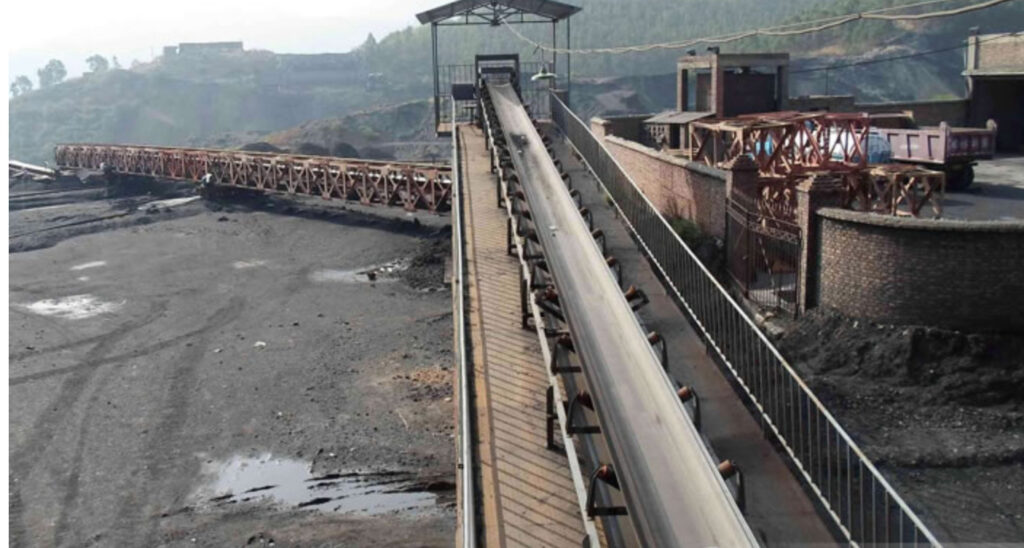
Working principle
The TD75 belt conveyor is mainly composed of two end – end rollers and the closed conveyor belt on the tight sleeve. The drum that drives the conveyor belt to turn is called the driving drum (driving drum); Another drum that only changes the direction of the conveyor belt is called a reversing drum. The driving drum is driven by a motor through a reducer, and the conveyor belt is driven by the friction between the driving drum and the conveyor belt. The driving drum is generally installed in the unloading end to increase the traction, which is conducive to drag. The material is fed into the feeding end, falls on the rotating conveyor belt, and is transported to the unloading end and discharged by the friction of the conveyor belt.
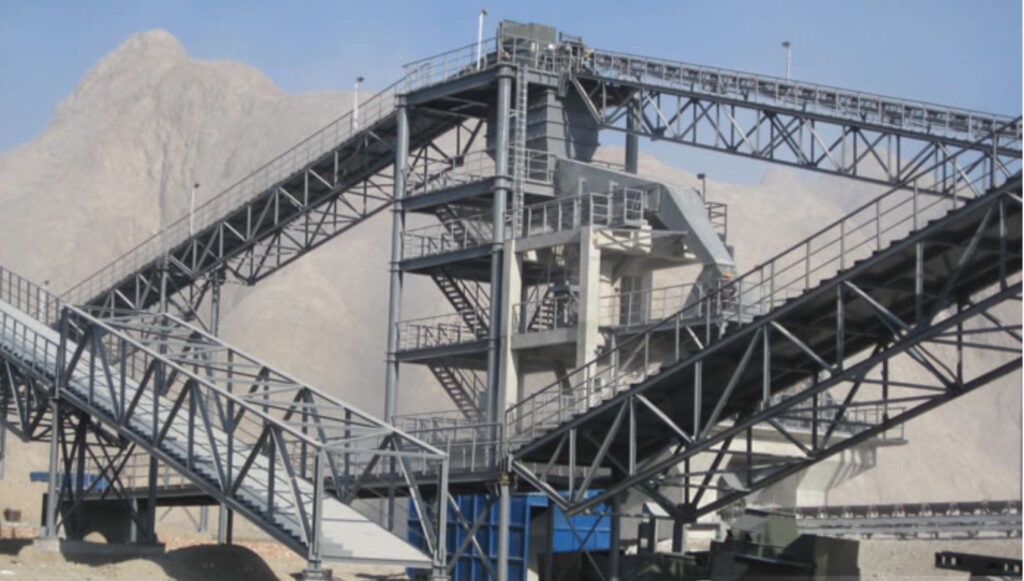
Technical parameter
Note:
1. The transport capacity in the table is calculated under the conditions of material bulk density Q (T /s), horizontal transport and idler groove Angle of 30°.
Type 2. DT. DI series belt conveyor is suitable for conveying various block stacking density is less than 1.2 t/m3, granular material, can also transport into items, DT. D Ⅱ type series belt conveyor is suitable for conveying stacking density of 0.8 2.5 t/m3 massive, granular material, also may transport into items.
Product Structure
1. Driving part: the motor, > high-speed coupling -> reducer -> deceleration coupling, is installed on the base welded with section steel. According to the layout requirements: the driving device is equipped with two kinds of left and right mounting. In addition, the company is equipped with oil-cooled electric rollers with power from 1.5kW to 13KW speeds of 0.80, 1.0 and 1.25.
2. Rolling part: there are two types of driving drum and reversing drum.
3. Idlers: slotted, parallel, aligning and cushioning idlers, etc.
4. Cleaning part: spring sweeper and empty sweeper.
5. Unloading part: fixed plough type unloader and electric unloader.
6. Braking part: there are two kinds of belt type backcheck and roller backcheck.
7. Accessories: In the housing, feeding trough, funnel, etc.
1. Under normal circumstances, TD75 belt conveyor requires no-load start, and avoid frequent start in a short time.
2. Must always check the reducer whether there is oil leakage, regular check whether the appropriate amount of oil, and timely replenishment.
3. Keep belt machine around, especially the driving device clean, timely cleaning belt machine and around the pulverized coal and debris, so as not to affect the normal work.
4. The idler with inflexible rotation should be replaced and repaired in time.
5. The driving drum should be kept clean, and the adhesion and moisture should be removed in time.
6. Found that the deviation of the tape to be adjusted in time, do not allow to wear away the phenomenon of tape edge. Kill. The adhesive tape joint should be checked frequently, and the damage should be repaired in time. The core part of the adhesive tape should be strictly waterproof. 8. Loading point to often check, prevent a large piece of material or foreign objects damaged or blocked exports, tear tape.
Operating procedures
1. Close the main power switch and check whether the equipment is normally supplied and whether the power indicator is on. Proceed to the next step after normal operation.
2. Close the power switch of each circuit and check whether it is normal. Under normal state, the equipment does not act, the belt machine running indicator is not on, the power indicator light of the inverter and other equipment is on, and the display panel of the inverter is normal (trouble-free code is displayed).
3. Start each electrical equipment in turn according to the process flow. Start the next electrical equipment after the last electrical equipment starts normally (the motor or other equipment has reached the normal speed and state).
Note:
First of all, in the operation of the TD75 belt conveyor, it is necessary to comply with the provisions of the design of the goods to be transported, to comply with the design capacity of the belt conveyor.
Secondly, all kinds of personnel should not touch the moving part of the belt conveyor, non-professional personnel are not allowed to touch electrical components, control buttons, etc.
Finally, in the belt machine operation can not be on the back stage of the converter break, if the maintenance needs are determined, it must be in the case of stopping the frequency conversion operation, otherwise the converter may be damaged. When the equipment stops running, press the stop button to cut off the total power supply after the system stops completely.

